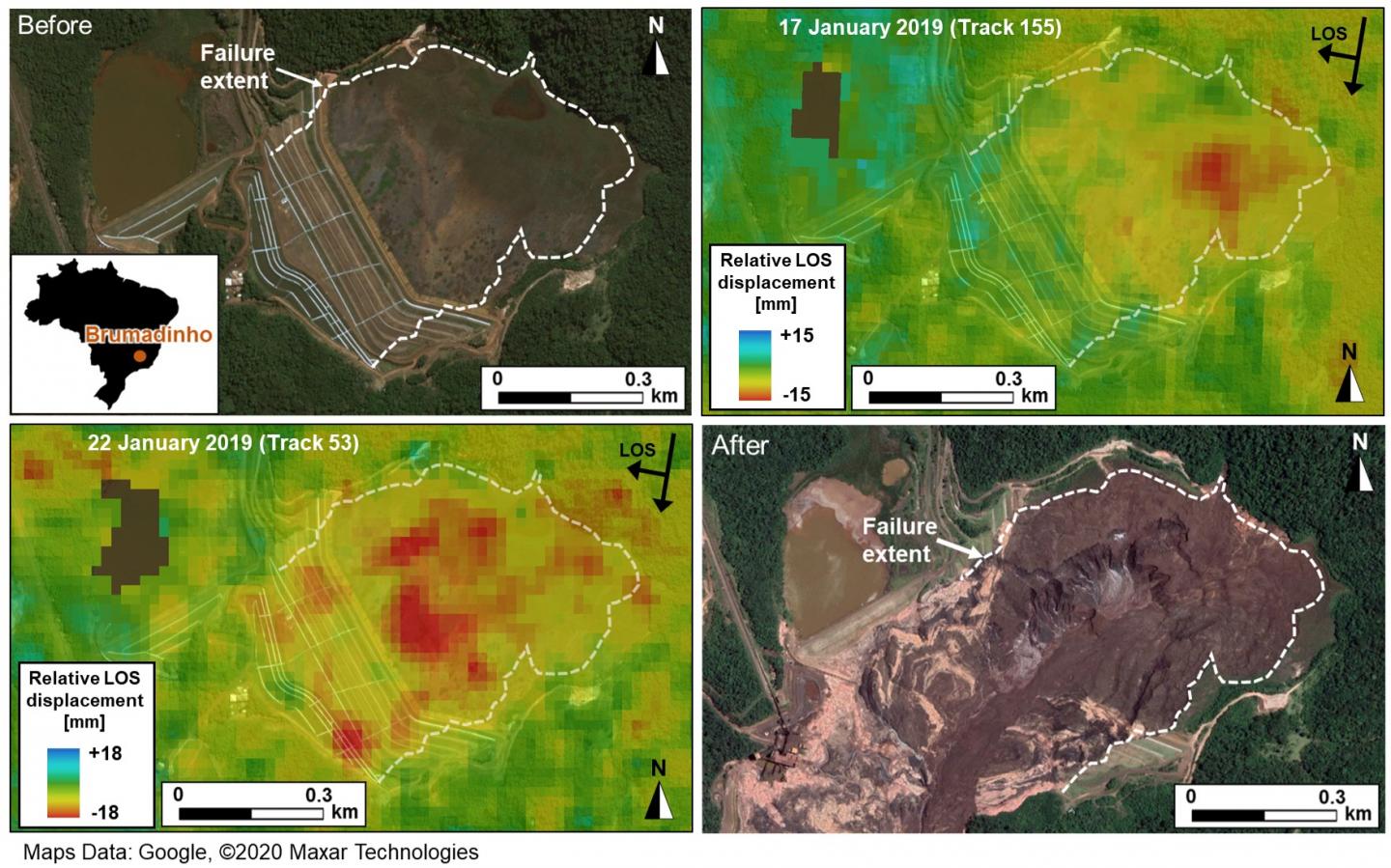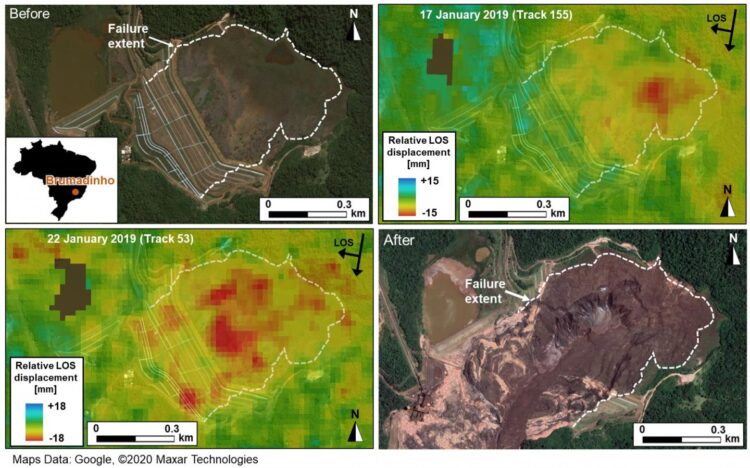
Credit: Google Earth
One of Brazil’s worst environmental disasters – a dam collapse that also killed more than 200 people – could have been foreseen with the right monitoring technology, according to a new study by the University of Nottingham and Durham University.
The high-profile catastrophe took place on 25 January 2019 at a tailings dam near the Córrego do Feijão iron ore mine, close to the town of Brumadinho, in Minas Gerais state, south-east Brazil.
When the dam collapsed, it caused a torrent of sludge to cover surrounding land; taking lives, destroying homes and livelihoods and polluting rivers with toxic material.
Owned by Vale, Brazil’s largest mining company, the tailings dam was used for more than 40 years to hold waste from the mine. While it is not uncommon for such dams to move as more material is added and it compacts and shifts, accelerated movement shouldn’t happen; it’s a precursor that failure will occur. Brumadinho was the second Vale-owned mining dam to collapse in recent years and one of many widely-reported failures worldwide.
There are growing concerns about the stability of this particular type of dam and a significant number need enhanced monitoring says lead author Assistant Professor Stephen Grebby from the Nottingham Geospatial Institute at the University.
Dr Grebby, an expert at mapping the Earth’s surface from space, said: “Most mining companies currently rely upon ground-based sensors to monitor the stability of dams. However, these typically offer an inadequate coverage of measurements over the whole of the dam, which can make it difficult to detect movement or other signs of distress.”
Applying InSAR (satellite radar imaging) to check for small ground movements in and around dams is not current standard practice and this is something Dr Grebby would like to see change.
He collaborated with Durham University and University of Nottingham spin-out company Terra Motion Ltd on the study to identify whether failure at Brumadinho could have been foreseen.
They used an advanced InSAR technique called Intermittent Small Baseline Subset (ISBAS), developed by the University of Nottingham and Terra Motion, which can help overcome the limitations faced when using some of the more conventional InSAR techniques over vegetated terrain. Another benefit of this technology, over on-the-ground sensors, is it looks down from above and offers a more complete picture of ground movements with millimetre-level accuracy.
Dr Grebby adds: “Our ISBAS InSAR results revealed that different areas of the dam were moving at different rates and some of these were seen to accelerate suddenly during the two months preceding the collapse. Despite the dam being monitored by the mining company using standard techniques with no apparent warning raised, our analyses of the precursory movement indicate the timing of the collapse was foreseeable.
“If monitored routinely, using the ISBAS InSAR technique, the failure date could have been predicted to within a week of it happening. Crucially, this prediction would have been possible around 40 days prior to the collapse, allowing time for a warning to be raised that the dam was becoming unstable. This could have led to more in-depth monitoring or other mitigation measures to avert the loss of life and environmental disaster that tragically unfolded.”
The full findings have just been published in the paper ‘Advanced analysis of satellite data reveals ground deformation precursors to the Brumadinho Tailings Dam collapse’ in the Nature journal Communications Earth & Environment.
Professor David Toll, Co-Director of the Institute for Hazard, Risk and Resilience at Durham University, said “Identifying an acceleration of ground movements during a period of wetting, just prior to the failure, helped to corroborate the anticipated failure mechanism. The collapse of the tailings dam can be explained by a reduction in suction in the tailings contributing to internal strains that could induce static liquefaction in the brittle materials.”
Professor Jon Gluyas, Executive Director of Durham Energy Institute at Durham University said, “The novel use of InSAR satellite data to monitor the stability of dams is a real breakthrough as it means that you don’t need to instrument the ground in and around the dam to monitor it. Monitoring is thus no longer solely in the hands of the operating company.”
Dr Andrew Sowter, CTO of Terra Motion Limited and inventor of the ISBAS advanced InSAR technique said, “This work would not have been possible without the availability of free satellite data from the Sentinel-1 mission which has global reach and is sustainable for the foreseeable future. Along with the innovative approach described in this paper and our unique InSAR products, this means that a low-cost operational remote tailings monitoring system is within reach at local, regional and even national scales anywhere in the world.”
The researchers are now looking to develop the technology as a software that could be offered to the mining industry, which is looking out for a reliable, early warning system to predict the risk of imminent collapse at tailing dams. Combined with on-the-ground sensors, Dr Grebby sees advanced InSAR techniques as a valuable addition to the monitoring tool box to evacuate and protect life.
###
More information is available from Dr Stephen Grebby, from the Department of Chemical and Environmental Engineering, University of Nottingham on 0115 951 3883 or [email protected] or Emma Lowry, Media Relations Manager (Engineering) on 0115 84 67156 or [email protected]
Notes to editors
The University of Nottingham
The University of Nottingham is a research-intensive university with a proud heritage, consistently ranked among the world’s top 100. Studying at the University of Nottingham is a life-changing experience and we pride ourselves on unlocking the potential of our students. We have a pioneering spirit, expressed in the vision of our founder Sir Jesse Boot, which has seen us lead the way in establishing campuses in China and Malaysia – part of a globally connected network of education, research and industrial engagement. We are ranked eighth for research power in the UK according to REF 2014. We have six beacons of research excellence helping to transform lives and change the world; we are also a major employer and industry partner – locally and globally. Alongside Nottingham Trent University, we lead the Universities for Nottingham initiative, a pioneering collaboration which brings together the combined strength and civic missions of Nottingham’s two world-class universities and is working with local communities and partners to aid recovery and renewal following the Covid-19 pandemic.
About Durham University
Durham University is a globally outstanding centre of teaching and research based in historic Durham City in the UK. We are a collegiate university committed to inspiring our people to do outstanding things at Durham and in the world. We conduct boundary-breaking research that improves lives globally and we are ranked as a world top 100 university with an international reputation in research and education (QS World University Rankings 2021).
We are a member of the Russell Group of leading research-intensive UK universities and we are consistently ranked as a top 10 university in national league tables (Times and Sunday Times Good University Guide, Guardian University Guide and The Complete University Guide).
For more information about Durham University visit: http://www.
Durham Energy Institute (DEI) is the hub of energy research at Durham University.
We produce world class research for understanding energy decarbonisation and deliver integrated solutions for the climate emergency incorporating social, policy and technical insights. We believe that by looking at energy systems in a holistic and integrated way the most effective solutions to global energy challenges can be developed and implemented.
For more information about Durham Energy Institute visit: http://www.
Institute of Hazard, Risk and Resilience (IHRR)
IHRR is a world-leading research institute in hazard, risk and resilience-based at Durham University. We support innovative research and training for use in policy and practice, collaborating directly with communities, NGOs and governments. Our commitment is to work with and learn from the widest possible range of stakeholders living with hazard and risk – empowering people, fostering resilience, and improving lives, both now and in the future. Find out more at https:/
Media Contact
Emma Lowry
[email protected]
Original Source
https:/
Related Journal Article
http://dx.






